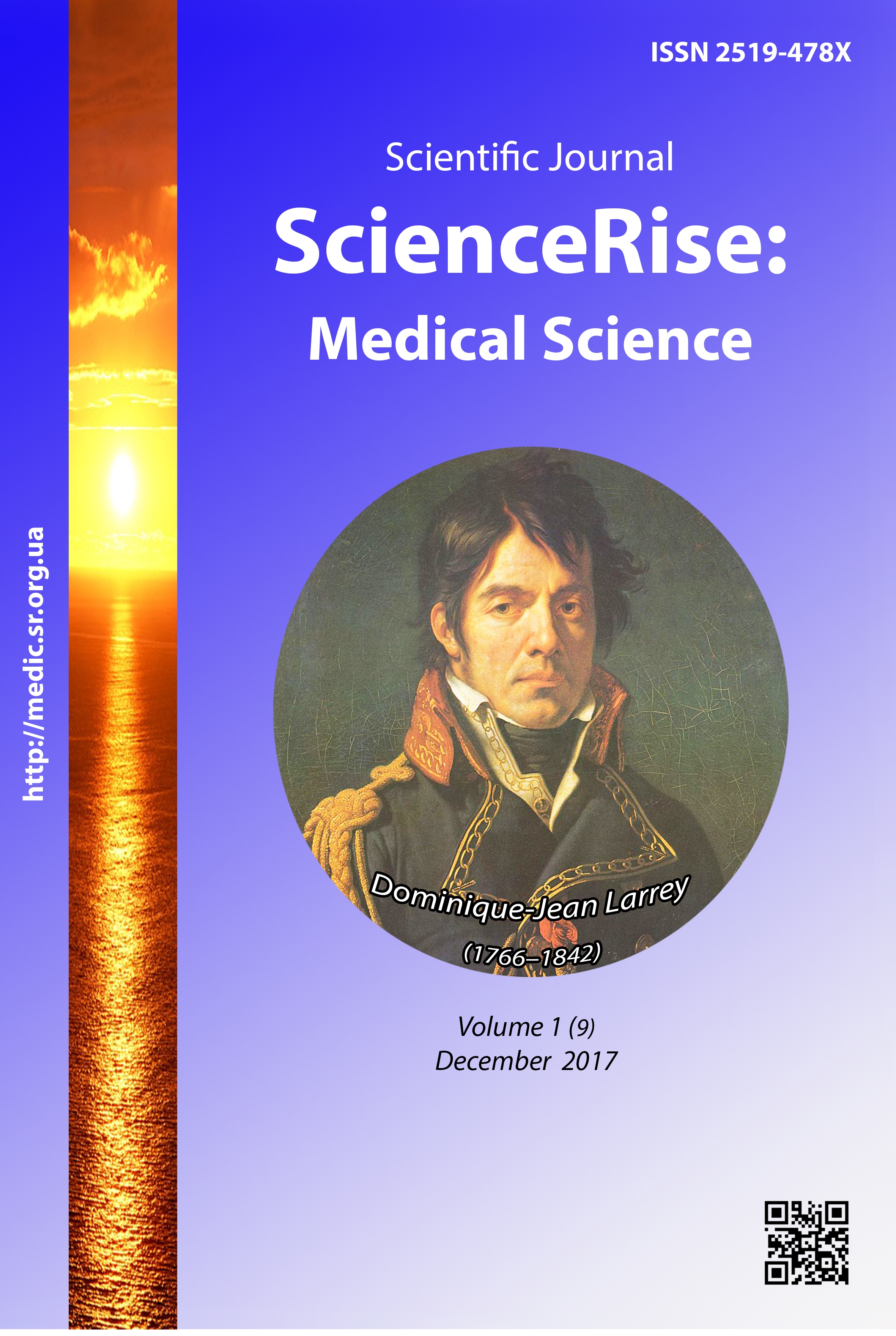Development of the system of psychotherapy of non-psychotic mental disorders and non-compliance in patients with the 2ND type diabetes mellitus
DOI:
https://doi.org/10.15587/2519-4798.2017.90996Keywords:
the 2nd type diabetes mellitus, psychopathological disorders, mental disorders, compliance, therapy, psychotherapyAbstract
Aim. Development of the system for psychotherapy of non-psychotic mental disorders and non-compliance in patients with the 2nd type diabetes mellitus to improve the treatment of the 2nd type diabetes mellitus in patients having non-psychotic comorbid mental disorders.
Materials and methods. 543 patients with the 2nd type diabetes mellitus were examined on the clinical bases of the Therapy, clinical pharmacology and endocrinology department of the State Institution “Zaporizhzhia medical academy of post-graduate education Ministry of health of Ukraine”. The patients were divided in 2 groups depending on the obtained treatment criteria: 270 patients with the 2nd type diabetes mellitus, having treatment with psychotherapy and psycho preventive steps by the developed approaches, formed the studied group. The other 273 patients formed the control group and were treated by the standard clinical protocols.
Methods of research: clinical and anamnestic, clinical and psychopathological, psychodiagnostical, and statistical.
Results and discussion. In result of research, the system of psychotherapy for the correction of psychopathological and pathopersonal disorders, as well as compliance achievement, in patients having the 2nd type diabetes mellitus was developed. The psychotherapy system consists of three main directions: the first is improvement of compliance to diabetes mellitus therapy and the formation of harmonic lifestyle with diabetes; the second is normalization of patients’ psycho-emotional condition; the third is correction of destructive behavior and personality qualities. The following therapeutic methods were used: psychological education, relaxation, CBT, hypnotic suggestion, body-oriented, rational emotive, and existential.
Conclusion. High efficiency of the developed system for neurotic manifestations leveling and improvement of compliance to the 2nd type diabetes mellitus has been proved
References
- Brojtigam, V., Kristian, P., Rad, M. (1999). Psihosomaticheskaja medicina. Moscow: GJeOTAR MEDICINA, 376.
- Grimes, R. T., Bennett, K., Hoey, H., Tilson, L., Henman, M. C. (2016). A retrospective cohort analysis of hypoglycaemic and cardiovascular agent use in young adults in the Irish primary care setting. Irish Journal of Medical Science, 1–10. doi: 10.1007/s11845-016-1491-x
- Jaacks, L. M., Siegel, K. R., Gujral, U. P., Narayan, K. M. V. (2016). Type 2 diabetes: A 21st century epidemic. Best Practice & Research Clinical Endocrinology & Metabolism, 30 (3), 331–343. doi: 10.1016/j.beem.2016.05.003
- Meetoo, D., McGovern, P., Safadi, R. (2007). An epidemiological overview of diabetes across the world. British Journal of Nursing, 16 (16), 1002–1007. doi: 10.12968/bjon.2007.16.16.27079
- Weng, J. (2016). Evolution in the Chinese Diabetes Society Standards of Care for Type 2 Diabetes. Diabetes/Metabolism Research and Reviews, 32 (5), 440–441. doi: 10.1002/dmrr.2826
- Bairy, S., Kumar, A. M. V., Raju, M., Achanta, S., Naik, B., Tripathy, J. P., Zachariah, R. (2016). Is adjunctive naturopathy associated with improved glycaemic control and a reduction in need for medications among type 2 Diabetes patients? A prospective cohort study from India. BMC Complementary and Alternative Medicine, 16 (1), 290. doi: 10.1186/s12906-016-1264-0
- Hamdan, A., Jabbour, J., Nassar, J., Dahouk, I., Azar, S. T. (2012). Vocal characteristics in patients with type 2 diabetes mellitus. European Archives of Oto-Rhino-Laryngology, 269 (5), 1489–1495. doi: 10.1007/s00405-012-1933-7
- Roy, T., Lloyd, C. E. (2012). Epidemiology of depression and diabetes: A systematic review. Journal of Affective Disorders, 142, S8–S21. doi: 10.1016/s0165-0327(12)70004-6
- Shlomo, M., Polonsky, K., Larsen, P. R., Kronenberg, H. (2011). Williams textbook of endocrinology. Vol. 12. Philadelphia: Elsevier/Saunders, 1920.
- Degmecić, D., Bacun, T., Kovac, V., Mioc, J., Horvat, J., Vcev, A. (2014). Depression, anxiety and cognitive dysfunction in patients with type 2 diabetes mellitus – a study of adult patients with type 2 diabetes mellitus in Osijek, Croatia. Collegium Antropologicum, 38 (2), 711–716.
- Wang, G., Zhang, Z., Feng, Y., Sun, L., Xiao, X., Wang, G. et. al. (2017). Telemedicine in the Management of Type 2 Diabetes Mellitus. The American Journal of the Medical Sciences, 353 (1), 1–5. doi: 10.1016/j.amjms.2016.10.008
- Bailey, C. J. (2016). Under-treatment of type 2 diabetes: Causes and outcomes of clinical inertia. International Journal of Clinical Practice, 70 (12), 988–995. doi: 10.1111/ijcp.12906
- Popa-Velea, O., Bubulac, L., Petrescu, L., Purcarea, R. M. (2016). Psychopathology and psychotherapeutic intervention in diabetes: particularities, challenges, and limits. Journal of Medicine and Life, 9 (4), 328–333.
- Perfect, M. M., Elkins, G. R. (2010). Cognitive-behavioral therapy and hypnotic relaxation to treat sleep problems in an adolescent with diabetes. Journal of Clinical Psychology, 66 (11), 1205–1215. doi: 10.1002/jclp.20732
- Gentili, P., Maldonato, А., Bloise, D., Burla, F., Coronel, G., Di Paolantonio, T. (2000). Personality variables and compliance with insulin therapy in Type 2 diabetic subjects. Diabetes, nutrition & metabolism, 13 (1), 1–6.
Downloads
Published
How to Cite
Issue
Section
License
Copyright (c) 2017 Ольга Виталіївна Ткаченко

This work is licensed under a Creative Commons Attribution 4.0 International License.
Our journal abides by the Creative Commons CC BY copyright rights and permissions for open access journals.
Authors, who are published in this journal, agree to the following conditions:
1. The authors reserve the right to authorship of the work and pass the first publication right of this work to the journal under the terms of a Creative Commons CC BY, which allows others to freely distribute the published research with the obligatory reference to the authors of the original work and the first publication of the work in this journal.
2. The authors have the right to conclude separate supplement agreements that relate to non-exclusive work distribution in the form in which it has been published by the journal (for example, to upload the work to the online storage of the journal or publish it as part of a monograph), provided that the reference to the first publication of the work in this journal is included.









